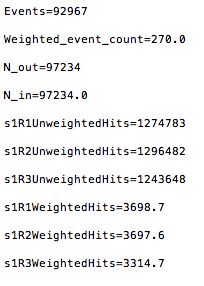Difference between revisions of "Weighted Occupancy"
Jump to navigation
Jump to search
CLAS12 Occupancy
Occupancy(50nA)=
Occupancy(75nA)=
Occupancy(100nA)=
Occupancy(50nA)=
Occupancy(75nA)=
Occupancy(100nA)=
Occupancy(100nA)=
CLAS12 Occupancy
Occupancy(50nA)=
Occupancy(75nA)=
Occupancy(100nA)=
Occupancy(50nA)=
Occupancy(75nA)=
Occupancy(100nA)=
| Line 61: | Line 61: | ||
<center><math>t_{sim}(100nA)=\frac{N_{in}}{\frac{50E-9\ A}{}\frac{1\ C}{1\ A}\frac{}{1\ s}\frac{1\ e^{-}}{1.602E-19\ C}}=\frac{N_{in}}{624,219,725,343\ e^{-}/s}=250E-9\ s\rightarrow N_{in}=156054.9\ e^{-}</math></center> | <center><math>t_{sim}(100nA)=\frac{N_{in}}{\frac{50E-9\ A}{}\frac{1\ C}{1\ A}\frac{}{1\ s}\frac{1\ e^{-}}{1.602E-19\ C}}=\frac{N_{in}}{624,219,725,343\ e^{-}/s}=250E-9\ s\rightarrow N_{in}=156054.9\ e^{-}</math></center> | ||
| + | |||
| + | Additionally, if we declare that every 2ns consists of a bunch of 1000 electrons each, then | ||
| + | |||
| + | <center><math>\frac{78027.5\ e^{-}}{\frac{1000\ e^{-}}{2e-9\s}}=78.041\times 2e-9\s=1.56E-7\ s</math></center> | ||
| + | |||
| + | |||
| + | <center><math>\frac{117041.2\ e^{-}}{\frac{1000\ e^{-}}{2e-9\s}}=117.041\times 2e-9\s=2.34E-7\ s</math></center> | ||
| + | |||
| + | |||
| + | <center><math>\frac{156054.9\ e^{-}}{\frac{1000\ e^{-}}{2e-9\s}}=156.0549\times 2e-9\s=3.12E-7\ s</math></center> | ||
==Method 2== | ==Method 2== | ||
Revision as of 04:59, 25 July 2018
Total XSect=0.013866
97234 incident electrons
Method 1
Using the unweighted amounts
Using the weighted amounts
The non-time terms can be considered to be constant since they are either simple number such as 12 or functions which depend on the same variables such as the number of hits and number of events (Both terms are found by ,thus are only multiples of each other). We can simplify this expression by:
If 250ns is the time limit, then solving the time of simulation backwards will give the number of incident electrons within that window.
Additionally, if we declare that every 2ns consists of a bunch of 1000 electrons each, then
Method 2
Using the unweighted amounts
Using the weighted amounts
